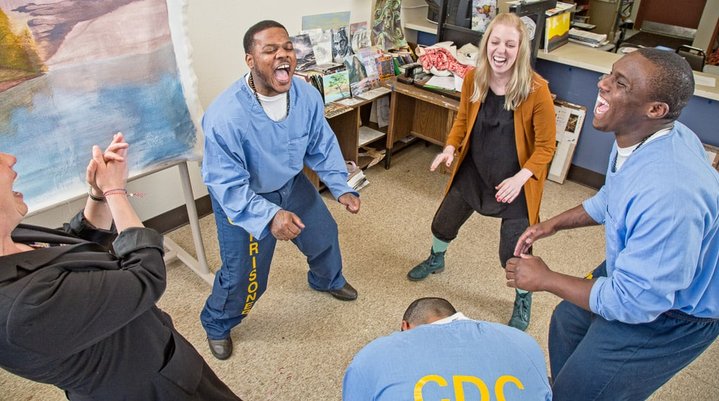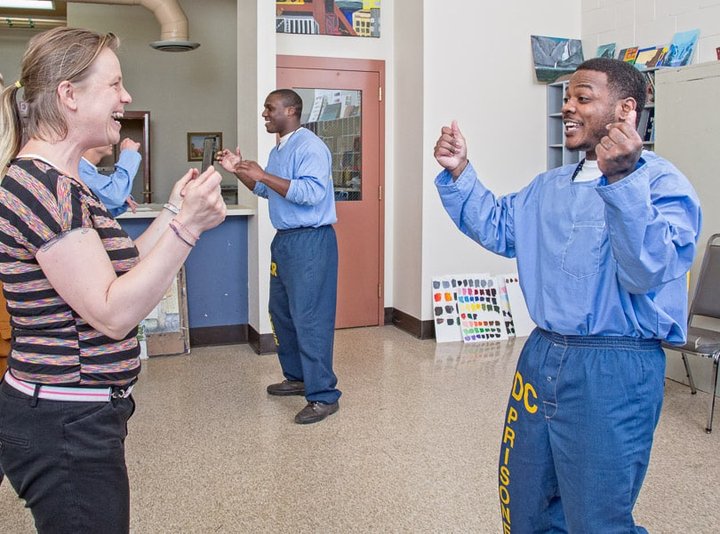Janessa Johnsrude teaches weekly ensemble theater classes at Pelican Bay State Prison through Dell’Arte’s Prison Arts Program. All photos contributed by Dell’Arte.
###
Janessa Johnsrude didn’t know what to expect when she and Zuzka Sabata began teaching ensemble theater through Dell’Arte’s Prison Arts Program at Pelican Bay State Prison, north of Crescent City. Neither of them had set foot in a prison, let alone the one “designed to house California’s most serious offenders,” but they believed they could make an impact.
“Everyone has a story,” Johnsrude, the program’s director and co-founder, told the Outpost in a recent interview. “Once you start to really speak with the people who are incarcerated [at Pelican Bay] – especially in the arts and theater classes – you get to explore vulnerability and humanity through storytelling. It really breaks down those barriers of stereotypes. There’s really a lot we can learn from individuals who are incarcerated.”
Dell’Arte’s Prison Arts Program partners with California’s Arts in Corrections Program and the William James Association to bring professional artists into the prison to provide a space where inmates can express themselves therapeutically through storytelling, improvisation and original play development. Johnsrude and Sabata initiated the program in 2015, starting off small with a class of just four minimum-security inmates. Nearly seven years later, they’ve worked their way up to nearly 50 students, several of whom have been released from prison and continue to participate in the program as mentors.
“When we first brought the Dell’Arte faculty in a couple of years ago, I remember a student turned to me and said, ‘This is the first time I’ve interacted with people who aren’t prison staff in over 10 years.’ That was a real breakthrough moment for me,” Johnsrude said. “It is really important to me to keep these programs robust so there is a level of socialization and interaction that happens beyond the day-to-day at the prison. I think that’s something that the arts program provides. Redemption through creativity is a really beautiful thing.”
It is a higher-risk environment, she said, but there are protocols in place “to make sure everyone is safe, including the students themselves.”
Studies have shown that inmates can benefit from the arts in a number of ways. A study published in the Justice Policy Journal identified positive correlations between arts education and such skills as time management, intellectual flexibility, emotional control and self-confidence among incarcerated individuals.
“These programs often provide authentic learning experiences that engage the minds and hearts of the incarcerated,” according to the study. “For example, arts education can lead to improved writing skills, greater intellectual agility and creativity, motivation, and enhanced performance in other academic disciplines.”
Evidence suggests that the artistic process can also provide a safe and acceptable way to express, release and deal with potentially destructive feelings such as anger and aggression, the study continued.
One of the program’s participants, a young man only identified by his first name, Kunlyna, said the program had done exactly that, providing him with a space to “release anger through acting.”
“As someone who’s really into psychology, I think that there [are] many forms of healing,” Kunlyna said in a video interview. “As adults, I think we get accustomed to dealing with our problems in a certain way, probably with violence. … In the arts, you can kind of convey that in painting. You can throw your emotions on paint. In writing, you can put it out in a poem or a story. In theater, you can just let it go.”
“We don’t know how to deal emotionally,” he continued. “I’m in here because I didn’t know how to deal with emotions and eventually somebody died because of that.”
Brian, another program participant, recognized the mistakes he and his fellow inmates had made in the past but said, “That doesn’t make us lifelong criminals.”
“I’m a man who was trying to survive a hard situation and trying to give back to his family, not a criminal,” he said. “I don’t think any of us are criminals. We may have made mistakes in the past that led to his being here and we’re being punished for that now.”
Dell’Arte recently hosted two performers from the Zimbabwe Theatre Academy, Cadrick (Khe Khe) Msongelwa and Ronald Sigeca, who explored the cyclical nature of the prison system in their physical theater production Zandezi, or “Prison” in Shona. The narrative focuses on a man who is wrongfully convicted of a crime and, when he eventually regains his freedom, is confronted by a world that will no longer accept him. He offends again and the cycle continues.
The actors visited Pelican Bay inmates earlier this week to discuss the play and to perform Next, a sequel to Zandezi that explores what happens after incarceration.
“We [went] to Pelican Bay and talked to people who are incarcerated about what their lives will be one day,” Msongelwa told the Outpost in a recent interview. “Some of them said, ‘I’m going to be out this soon and I want to do this or this.’ We want to know how they want to live their lives when they’re out after spending life in prison.”
Arts programs can serve as a tool to bridge the gap between prisoners and the outside world, he continued. “It’s really, really important to have these art programs because it brings people from the outside world in … but it also provides an opportunity for the inmates themselves to create stories and give us insight about the realities they’re facing.”
Though the play is not finished, Msongelwa and Sigeca plan Next with the following soliloquy:
“So, what next? New opportunities? New possibilities? New challenges? This echoes in my mind. So, what next? Being out here seeing, listening, and encountering the beautiful colors, chaotic sounds, people again. I once lost all of this but not this time. We know what happens to us after we die; we go to heaven or hell. But what happens to us after we are released from zandezi?”
###



CLICK TO MANAGE